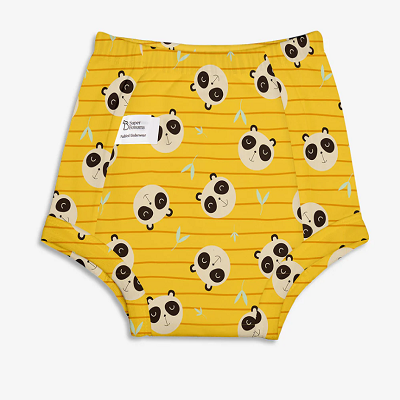Embarking on the potty training journey is a significant milestone for toddlers and parents alike. Knowing the right time to transition from diapers to using the potty is essential for a successful and stress-free experience. Potty training pants and potty-training underwear can play a crucial role in this process, but determining when to introduce them requires an understanding of your child’s signs of readiness and finding the perfect timing. In this informative guide, we’ll explore the critical indicators of potty training readiness and offer insights into the ideal timing to begin this exciting phase of your child’s development. By recognizing these signs and using the appropriate training pants, you can set the stage for a positive and empowering potty training journey.
When To Start Potty Training?
Potty training is a significant developmental milestone for toddlers, marking their transition from diapers to using the toilet independently. As a parent or caregiver, knowing the right time to start potty training can make this journey smoother and more successful. Alongside potty training pants, baby training pants can play a crucial role in this process. In this comprehensive guide, we’ll explore the signs of readiness to help you determine when your child is ready for potty training and how to use training pants to facilitate the transition. By understanding these essential aspects, you can embark on the potty training adventure with confidence and create a positive experience for your little one.
- Age and Developmental Readiness:
Determining the ideal age to start potty training is a common concern for parents. While many children begin showing signs of readiness between 18 and 24 months, it’s crucial to remember that every child is unique. Instead of solely relying on age, consider your child’s developmental readiness. Look for indications of physical development, such as walking steadily and pulling pants up and down independently. Cognitive development, like following simple instructions and understanding primary language, is crucial for successful potty training.
- Signs of Readiness:
Observing your child for signs of readiness is essential before starting potty training. Look for cues like showing interest in the potty, imitating older siblings or adults using the toilet, or displaying curiosity about the bathroom. If your child can communicate their needs and discomfort, it indicates a growing awareness of bodily sensations, a positive sign for potty training success.
- Introduce Potty Training Pants:
Potty training pants and potty training underwear serve as vital tools during this transition. These specially designed garments provide an intermediate step between diapers and regular underwear, offering comfort and absorbency while allowing your child to feel the wetness, promoting awareness. They are available in various sizes and styles to suit your child’s needs, ensuring a smooth and comfortable experience during potty training.
- Create a Supportive Environment:
Building a supportive and encouraging environment is critical to successful potty training. Please set up a designated potty training area and involve your child in choosing their training pants, making them feel involved and excited about the process. Be patient, understand that accidents are part of the learning process, and celebrate small successes with praise and positive reinforcement.
- Establish a Routine:
Consistency is vital when starting potty training. Establish a regular potty schedule and take your child to the potty at specific times, such as after meals or upon waking up. Encourage your child to use the potty regularly, even if they don’t feel the urge, to create a routine and reinforce the habit.
- Be Prepared for Setbacks:
Potty training is a learning experience, and setbacks are common. Be prepared for occasional accidents and regressions, especially during stress or change. Stay patient and supportive, avoiding punishment for accidents, as this can create anxiety and hinder progress.
4 Things You Need Before Starting Potty Training For Your Child
Potty training is a significant milestone for toddlers, and preparing for this new phase is essential to ensure a successful and positive experience. Before embarking on the potty training journey with your child, there are four key things you need to get equipped with:
- Potty Training Gear:
Invest in essential potty training gear to create a comfortable and supportive environment. Start with a child-sized potty chair or a potty seat that fits securely on your regular toilet. Both options allow your child to feel safe and stable during potty time. Additionally, consider using potty training pants or underwear designed specifically for this transition. These pants provide a bridge between diapers and regular underwear, allowing your child to feel wet while providing some absorbency for minor accidents.
- Potty Training Supplies:
Gather all the necessary potty training supplies to make the process convenient and accessible. Keep a stash of flushable wipes, toilet paper, and hand sanitizer near the potty area for easy cleanup. You may also want a handy step stool to help your child reach the sink for handwashing, promoting good hygiene habits.
- Patience and Positive Reinforcement:
Potty training is a learning process, and it requires patience and understanding from parents and caregivers. Be prepared for accidents and setbacks and avoid expressing frustration or disappointment. Instead, use positive reinforcement, praise, and encouragement for each successful potty use. Celebrate even the smallest achievements to build your child’s confidence and enthusiasm for potty training.
- Establish a Routine:
Consistency is crucial for potty training success. Establish a regular potty routine by taking your child to the potty at specific times, such as after meals, before bedtime, and upon waking up. Encourage your child to use the potty regularly, even if they don’t feel the urge, to develop a habit and reinforce the learning process.
Remember that every child is unique and potty training readiness varies from one individual to another. Some children may show signs of readiness as early as 18 months, while others may be ready closer to age 2 or beyond. It’s essential to observe your child’s cues, show support, and create a positive and encouraging environment during this exciting journey. With the proper preparation and love, your child will soon master potty training and take this significant step toward independence and growth.
Why SuperBottoms Padded Underwear Is Best To Potty, Train Your Child?
SuperBottoms Padded Underwear is the best choice for potty training your child due to its exceptional features and design. These specially crafted underwear offer the perfect blend of comfort and functionality, making the transition from diapers to potty seamless and stress-free. The high absorbency feature helps manage minor accidents, allowing your child to feel wet while protecting against leaks. The soft and breathable fabric ensures optimal comfort, encouraging your child’s enthusiasm for potty use. With SuperBottoms Padded Underwear, you can foster independence and confidence in your child, making the potty training journey an empowering and successful experience for both of you.
Conclusion
In conclusion, knowing when to start potty training is a critical factor in ensuring a smooth and successful transition for your child. By recognizing the signs of readiness, such as age-appropriate developmental milestones, the ability to communicate needs, and showing interest in the potty, you can determine the ideal timing to begin this exciting journey.
Remember to create a supportive environment, establish a routine, and be patient throughout the learning process. With the right timing and tools, you can make potty training a positive and empowering experience for your little one, paving the way for a successful transition from diapers to using the potty




